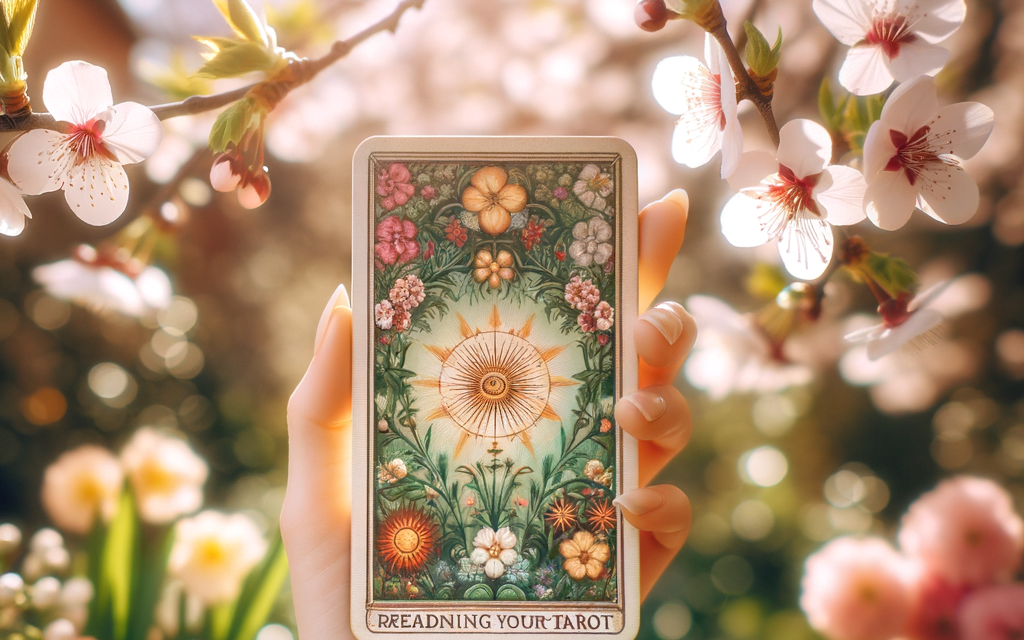Introduction
As the seasons change and we welcome the fresh bloom of spring, it’s a perfect time to reflect on personal growth and seek new paths to wellness. Tarot cards and divination tools have been used for centuries as a means to gain insight, find direction, and tap into one’s intuition. In the spirit of rejuvenation that comes with spring, learning to read tarot cards can be a transformative practice for self-discovery and empowerment, especially for those on a journey of health and wellness.
Understanding Tarot Cards
Tarot is a deck of 78 cards, each with its own imagery, symbolism, and story. The deck is divided into two sections: the Major Arcana, which represents life’s karmic and spiritual lessons, and the Minor Arcana, which reflects the trials and tribulations of daily life. The cards are used in a spread to gain insight into past, present, and future circumstances, offering guidance and perspective.
Choosing Your Tarot Deck
- Connect with your intuition: When selecting a tarot deck, let your intuition guide you. Look for imagery that resonates with you and makes you feel connected to the cards.
- Research different decks: There are many tarot decks available, each with its own theme and artwork. Spend time exploring various options to find one that speaks to you.
- Consider the quality: A good quality deck will last longer and be more enjoyable to handle. Opt for cards that are well-made and durable.
Here are a few tarot decks that might resonate with you:
- LHTHT Tarot Cards – This deck is perfect for beginners and expert readers alike, complete with a book set and a luxurious black gold storage box.
- 78 PCS Original Tarot Cards And Book For Beginners Set – Featuring the classic Pamela Colman-Smith Waite Rider Deck, this set comes with a 100-page guide book, ideal for those starting their tarot journey.
- Smoostart 78 Tarot Cards with Guidebook – A classic deck that suits both beginners and professional players, offering a future telling game experience.
- Tarot Cards Deck with Guidebook – This borderless classic 78-tarot deck box set features high gloss colorful glowing cards, perfect for those who appreciate a more visual experience.
- Touchfutrue Tarot Cards – A classic tarot card and book set for beginners, featuring the Rider Waite Tarot Deck and a 100-page guide book.
Getting Started with Tarot Reading
- Create a peaceful space: Find a quiet, comfortable area where you can relax and focus. You may want to light candles, burn incense, or play calming music to set the mood.
- Clear your deck: Before using your new tarot deck, it’s important to clear it of any previous energy. You can do this by shuffling the cards, knocking on the deck, or passing the cards through sage smoke.
- Formulate your question: Think of a question or area of your life where you seek guidance. Keep your question open-ended rather than yes/no for a more insightful reading.
- Shuffle the cards: While focusing on your question, shuffle the tarot cards. There’s no right or wrong way to do this; just ensure the cards are well mixed.
- Choose your spread: Decide on a tarot spread that fits your question. A simple three-card spread representing past, present, and future can be a great start for beginners.
- Interpret the cards: Lay out the cards in the chosen spread and begin interpreting the symbols and figures. Use a guidebook if you’re new to tarot, and remember that the cards’ meanings can be influenced by their position and surrounding cards.
Tips for a Fulfilling Tarot Practice
- Keep a tarot journal: Write down your readings and reflections to track your progress and personal growth over time.
- Practice regularly: The more you work with your tarot deck, the more familiar you’ll become with the cards and their meanings.
- Trust your intuition: While guidebooks are helpful, trust your own interpretations and feelings as you read the cards.
- Be patient: Learning tarot takes time, so be patient with yourself as you explore this new tool.
Common Mistakes to Avoid
- Don’t rush your readings: Take the time to truly connect with the cards and your question.
- Avoid becoming dependent: Use tarot as a guide, not a crutch. It should empower you to make decisions, not make them for you.
- Don’t fear the cards: Some cards, like Death or The Tower, may seem negative, but they often represent change or transformation rather than something to fear.
Conclusion
Embracing tarot reading as part of your springtime journey can open doors to self-awareness and personal growth. As you shuffle your cards and ponder their meanings, remember that tarot is a tool for reflection, not fortune-telling. It’s a means to understand yourself better and to navigate life’s challenges with greater clarity. With patience and practice, tarot can become a cherished part of your wellness routine, offering insights that align with the natural renewal of the season. So, breathe in the fresh spring air, shuffle your deck, and let the journey of self-discovery begin.









